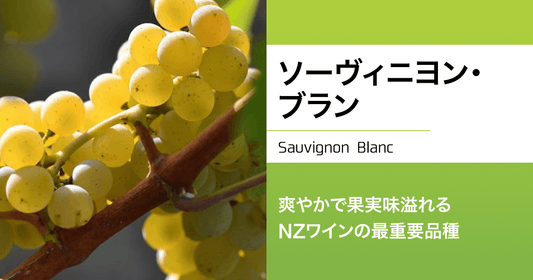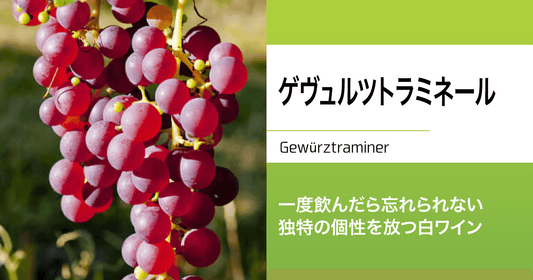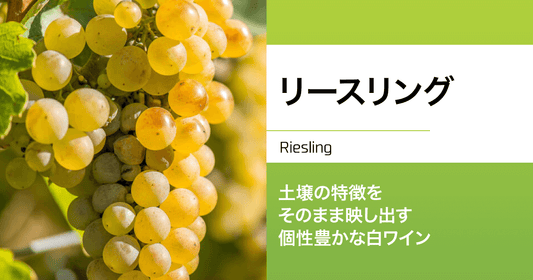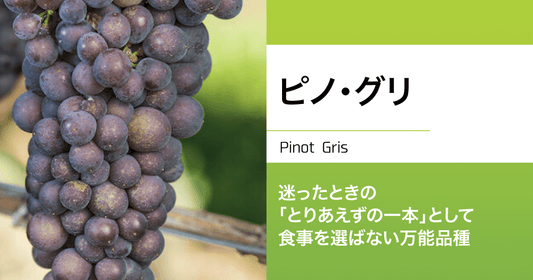
Merlot, with its gentle flavor and mellow mouthfeel, is a red wine grape variety that is popular among Japanese people.
Red wine is often made by mixing it with other wines, a process known as Bordeaux blending , and Merlot plays a major role in supporting the wine.
It goes particularly well with the powerful and astringent Cabernet Sauvignon , and the two varieties are known as a great combination.
On the other hand, its gentle flavor has earned it a reputation for being easy to drink, and single-varietal wines are also popular.
Merlot is also resistant to disease, easy to grow, and has little regional variation, so it is grown all over the world.
Merlot is an essential red wine. Let's discover its secrets.
The smooth and silky taste is best blended with Cabernet Sauvignon.
Merlot originates from the Bordeaux region of France.

The taste is smooth and silky, which is hard to imagine from its deep purple color.

Merlot has a gentle flavor with low levels of tannins and acidity, which are the astringent components of red wine, and is often blended with other red wine grape varieties.
It also lends itself well to aging, as it finishes aging quickly, making it an easy variety for winemakers to work with.
Commonly blended varieties
- Cabernet Sauvignon
- Cabernet Franc
etc.
When comparing Cabernet Sauvignon and Merlot, there are some differences:
| Cabernet Sauvignon | Merlot | |
|---|---|---|
| Taste | Rich in tannins, a bitter component, it has a rich and powerful flavor. | Soft acidity, low tannins, fine grain |
| Harvest time | Late maturing | precocious |
| climate | Requires plenty of sunlight and dislikes humidity | Grows in mild climates and high temperatures and humidity |
When you compare them like this, you can see that they have characteristics that are the complete opposite of Cabernet Sauvignon.
That's right. It is precisely because of the unique characteristics of each variety of grape that great wine is produced.
Merlot and Cabernet Sauvignon have opposing characteristics, so planting them together acts as an insurance policy for grape growers. (※Grapes can change in quality depending on the weather.)
Because it has a very mild taste, Merlot is popular not only as a secondary variety in blends, but also as a wine on its own.
What is it called and what are its parent varieties?
Wine grape varieties are produced all over the world, so their names can vary from region to region.
For example, Chardonnay is called Moulon d'Arbois in some parts of France, but Merlot is Merlot everywhere in the world, so there's no confusion.
It is known that one of the parents of Merlot is Cabernet Franc .
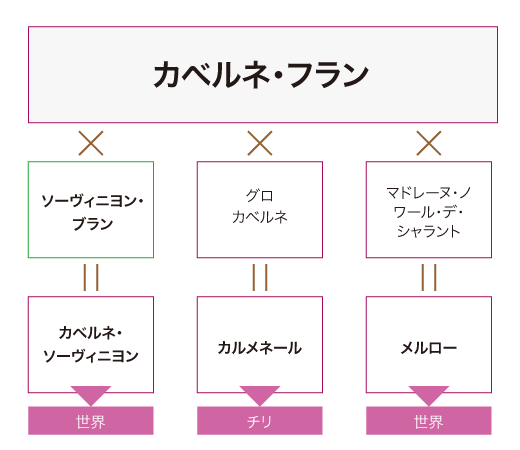
As you can see from this chart, Merlot can be considered a half-sibling of Cabernet Sauvignon and Carmenere.
The nose is rich with fruity aromas of plum, dark cherry and strawberry, with barrel aging adding notes of chocolate and, with age, notes of leather and leaf mould.
It has a soft acidity and finely-grained tannins, which give it a bitter taste, and is gentle and mellow on the tongue, with a strong fruity flavor.
If you choose a single Merlot variety, we recommend a lightly seasoned meat dish.
Merlot is a wine with a gentle flavor, so it is said to suit the Japanese palate well.
Red wine is often said to go well with strong-flavored foods such as beef and game, but Merlot has a mild flavor and will be overpowered if you pair it with food that has a very strong flavor.
The mellow Merlot goes well with Western dishes such as chicken dishes and stews.
In terms of Japanese cuisine, it goes well with sweet and salty dishes.
Merlot goes well with Japanese food. What kind of food would you recommend?
My recommendation is sukiyaki, which goes really well with soy sauce-based sauce.
Wow! I'll try making sukiyaki this weekend and pairing it with Merlot.

Other than that, if it's Japanese food,
- Eel

- Beef bowl
- Nikujaga (beef and potatoes)
We recommend combining it with other items such as:
A variety loved in many regions of both the old and new worlds
Merlot is widely cultivated around the world because it is easy to grow.
Representative areas include
- Bordeaux/Southwest France
- Italy
- South Africa
- Chile
- Argentina
- North America California
- Nagano, Japan
And more.
France
Merlot is still widely cultivated in France, where it originated.
The cultivated areas in France are as follows:
- Merlot: 114,631ha
- Grenache (red wine grapes) - 85,4084ha
- Ugni Blanc (white wine grapes) - 84,464ha
It has a big lead over the second place.
It's quite surprising that it's number one in France. It's easy to see why it's such a great supporting actor.
It is a popular variety in Bordeaux blends and is mainly grown in the Bordeaux region of France.
The Saint-Emilion region is especially famous for its Merlot. It has a history of winemaking dating back to Roman times, and its climate and soil are said to be ideal for growing Merlot.
Japan (Nagano)
Merlot is a popular grape variety in Japan as well.
Japan's hot and humid climate is a good match for Merlot.
Japanese Merlot is really delicious.
For red wine grape varieties, Japan's production volume is as follows (2016):
- Muscat Berry A
- Concord
- Merlot
The area around Shiojiri City in Nagano is known as a famous Merlot producing region.
Hawke's Bay is New Zealand's leading producer.
Most of New Zealand's Merlot comes from Hawke's Bay , a renowned wine region in the North Island.

This is because the Hawke's Bay region has plenty of sunshine, which is ideal for late-ripening Merlot, which prefers a warm climate.

NZ Merlot is often blended with Cabernet Sauvignon and is not often used on its own.
▶ Merlot wine sold at Bokumo Wine
summary
A Merlot with rich fruitiness, mild tannins and a soft mouthfeel.
This is an excellent variety that can play a leading role or a supporting role in a Bordeaux blend.
Its mellow flavor goes perfectly with Japanese food.
Please give it a try.



